Every gardener out there can benefit from having floating row covers on hand. They’re lightweight, easy to store, and inexpensive. And their uses go well beyond frost protection.
Don’t be discouraged if you aren’t up for building a mini hoop house either.
In many cases, garden fabric can be draped directly on top of plants and secured around the perimeter. So the effort involved is often minimal.
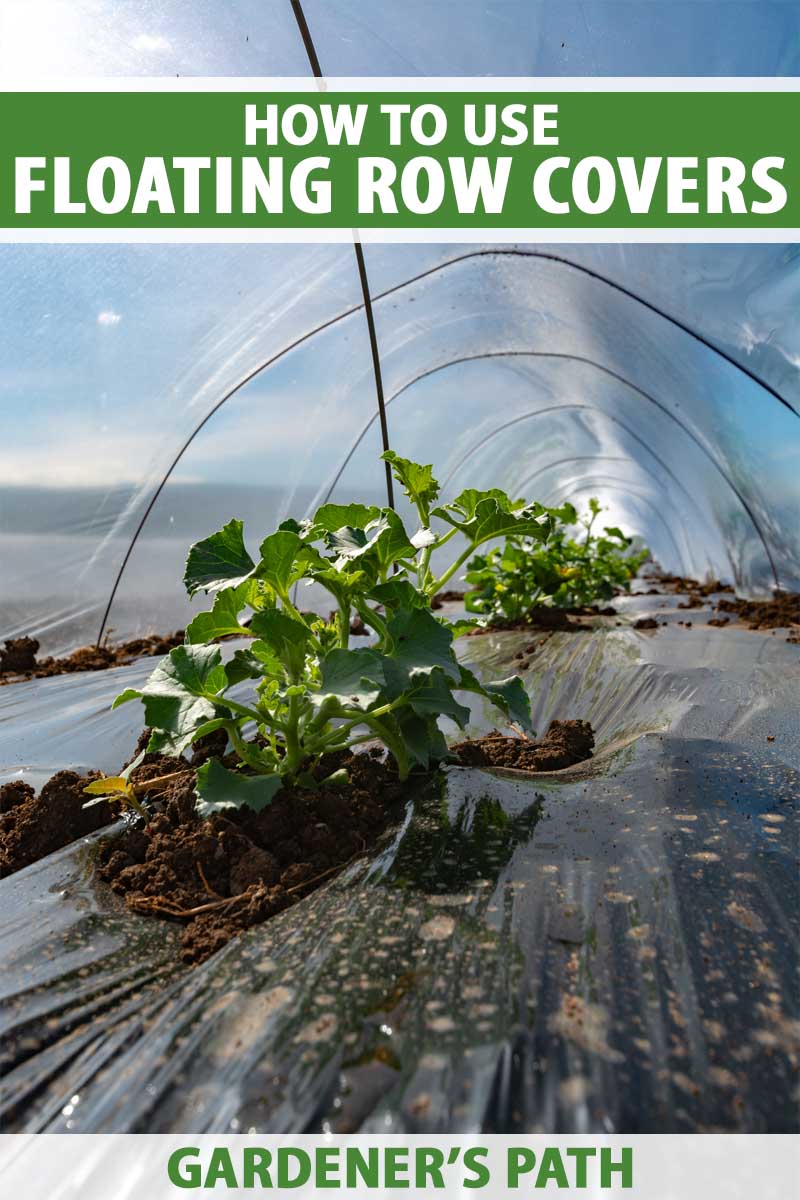
We link to vendors to help you find relevant products. If you buy from one of our links, we may earn a commission.
Keep reading for a short list of all the ways you can use floating row covers in your garden, how to pick the right types for your needs, and some tips to avoid possible pitfalls.
What Is It?
Floating row cover, also known as garden fabric, is a white, thin, light piece of material used to shelter crops for a number of reasons, the most well-known being for frost protection.
It’s typically made from polypropylene or polyester and doesn’t absorb moisture. It does, however, allow rainfall and sunlight to pass through. One piece can last multiple seasons, depending on how extensively it’s used each year.
Why Bother?
1. Protect Warm Season Crops Against Frost
I don’t know a single gardener who doesn’t wish for more time every season. Well, garden fabric can actually allow you more time to grow warm season crops.
Garden fabric varies in weight and density. To keep plants protected from frost, you’ll need a heavier weight material that is specifically created to trap heat.
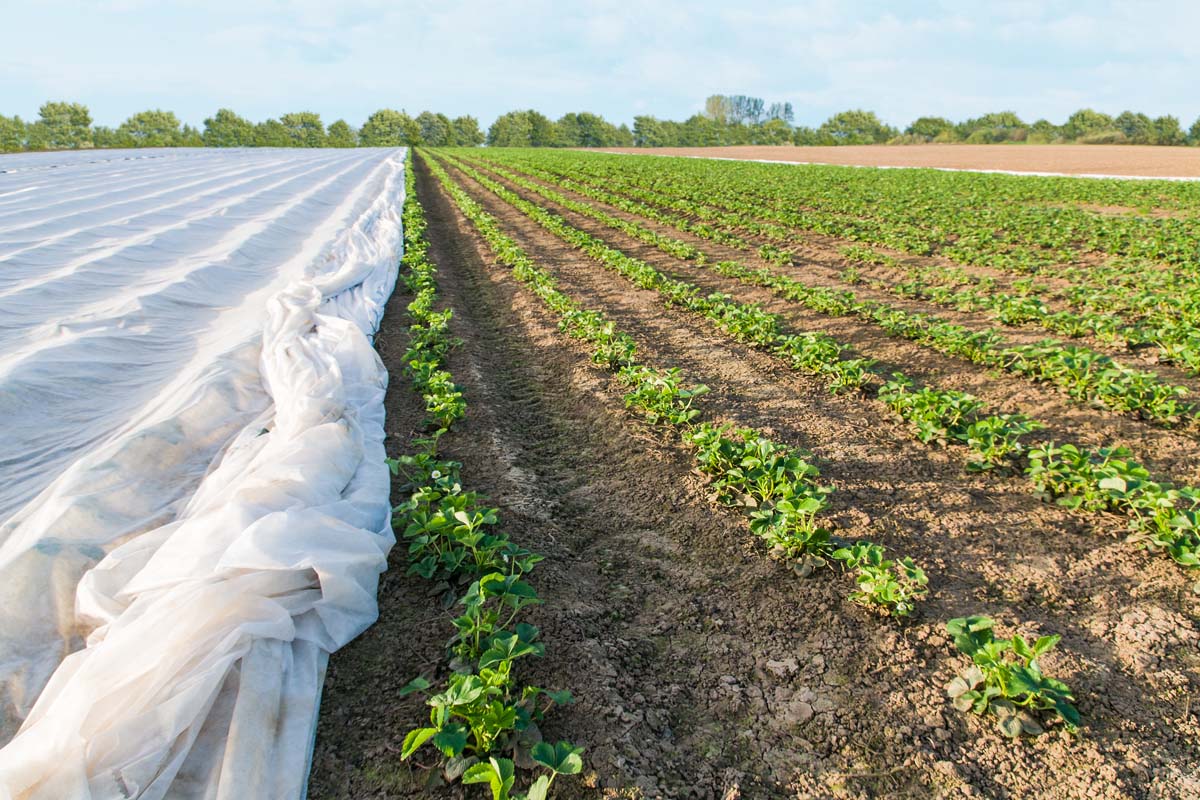
Gardens protected with heavy weight floating row covers are typically 4 to 10°F warmer during freezing temperatures.
For short-term frost protection, all you need to do is loosely lay material over the plants that are at risk and secure it around the perimeter with rocks or soil.
Knowing you have this option will relieve stress and give you the opportunity to set out heat loving, long season edibles, like tomatoes, bell peppers, and hot peppers, earlier than usual. Peppers especially need warmer temperatures to thrive, so employing garden fabric can really make a difference.
If allowing plants to grow under cover for any length of time, it’s best to build a support structure to increase airflow, allow for plenty of room to grow, and avoid any damage that may be caused to the plants by unsupported fabric beating in the wind.
Also, you’ll want to make sure you use a fabric that still allows plenty of light through.
2. Protect Cool Season Crops from Heat, or Warm Them Up in Winter
Row covers also allow you to extend the harvest of cool weather crops such as kale by providing relief from the hot sun.
If you are trying to protect leafy greens like lettuce and spinach from bolting too soon during a fluke warm spell, lightweight row covers may just do the trick.
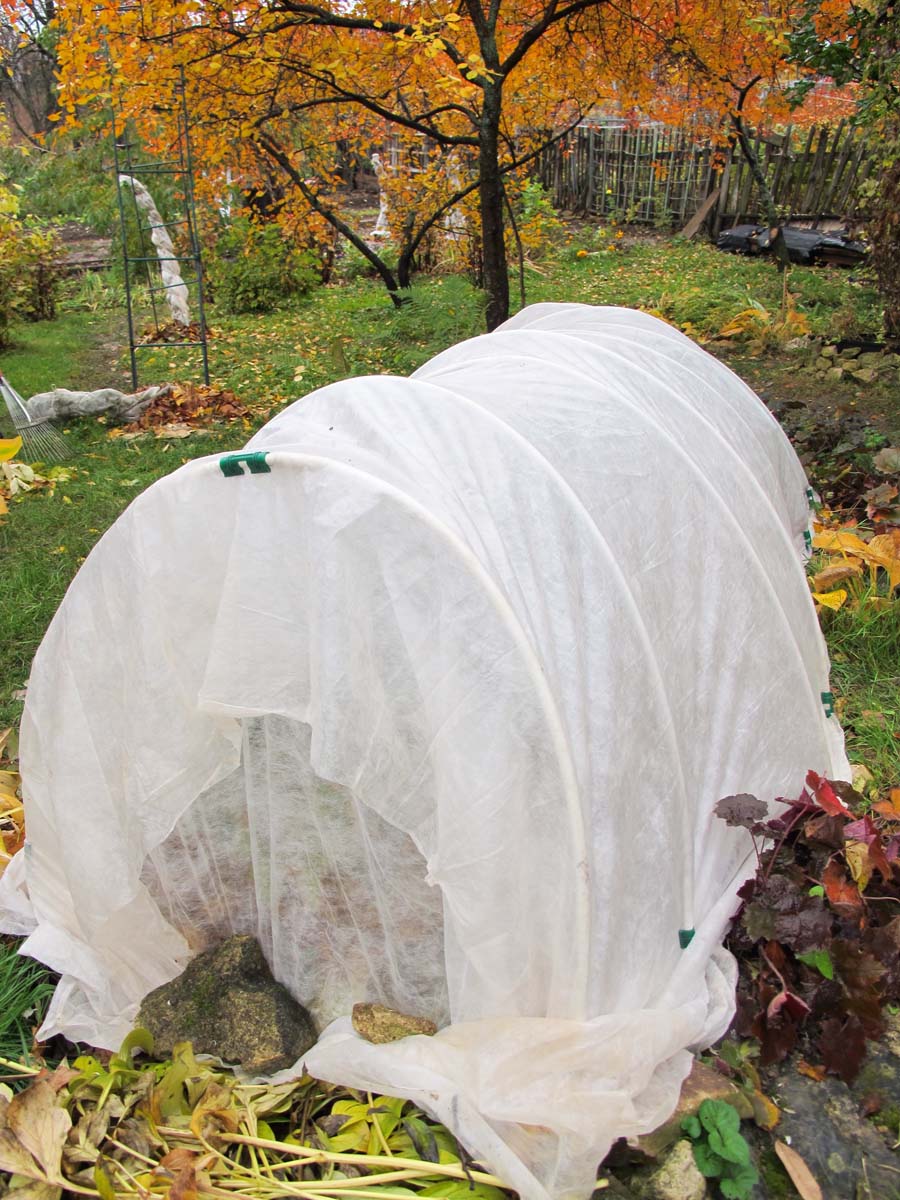
Ideally, they will allow for plenty of air circulation, but still block a good amount of sunlight. Garden fabric is a great option if the weather starts heating up early in the spring, or at the end of summer when starting a fall crop.
Also keep in mind that if you are in a region that is exceptionally hot or cold, garden fabric has the potential to allow you to grow edibles you otherwise couldn’t grow.
You can also use heavyweight row covers through the winter to grow some hard frost tolerant vegetables, like cabbage and kale. This works especially well if winters are usually mild in your area.
3. Keep Pests Out
A lightweight floating row cover can change everything if insects, rabbits, or deer often feast on your plants. Look for ones that are marketed for this purpose.
If you will be leaving covers on throughout the season, it’s important to make sure they aren’t heavyweight and meant to trap heat.
Leafy vegetables, root vegetables, and self-pollinating edibles can be grown under the protection of garden fabric from seed to harvest. Bush beans are a great candidate for this.
In order to effectively keep pests out, it’s important to secure material well with staples or soil.
4. Reduce Transplant Shock
Seedlings grown indoors often can’t handle the stress of outdoor weather right away.
So, seedlings are typically hardened off, which means they are slowly introduced to the outdoors before being transplanted into the garden.
Instead of hardening plants off by setting seedlings out for extended periods of time over the course of several days, you could place plants under the protection of a lightweight row cover instead. This will cut the intensity of the weather and give plants a chance to become established.
Check Plants Often
If using row covers for an extended period of time, there are several issues to keep in mind:
First, many insects overwinter in the soil, so be mindful of any insect issues that you have had in the past, so you know where to look.
As such, crop rotation is especially important if using row covers for protection against insect pests.
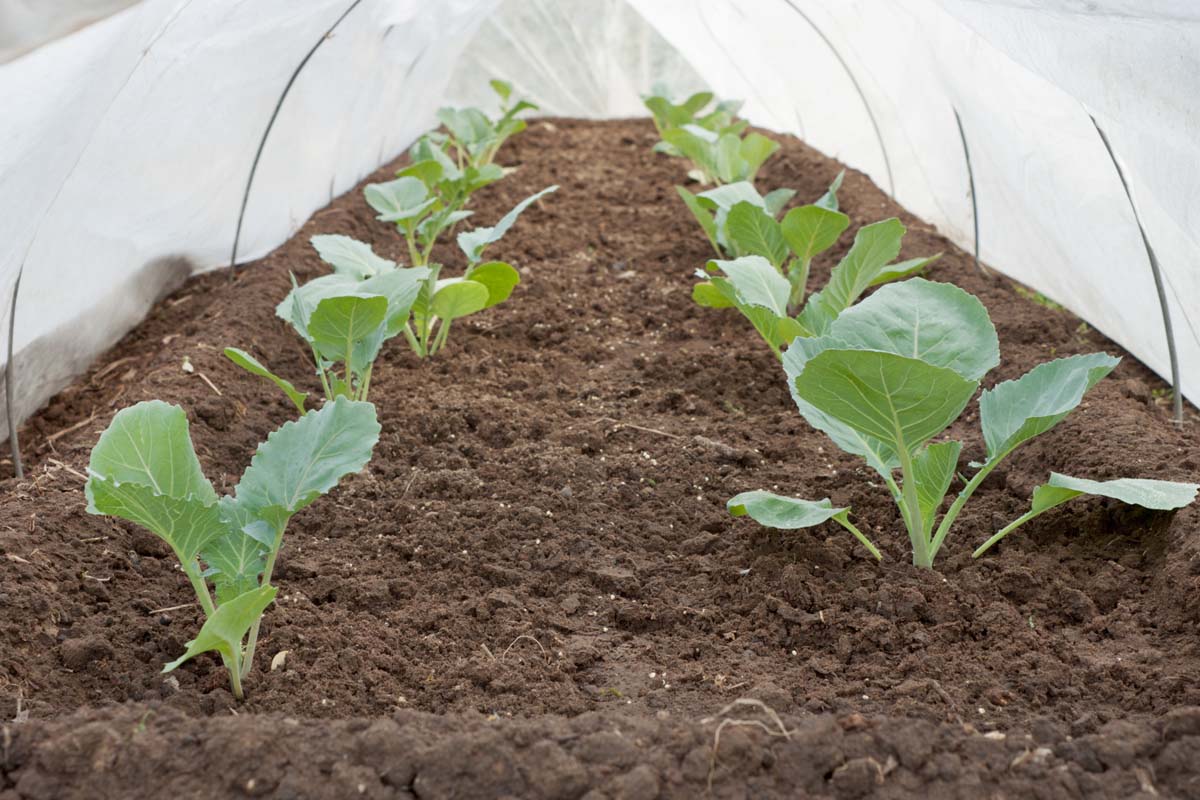
The last thing you want to do is to trap pests that emerge from the soil in with your edibles! So be very vigilant. If you notice any insect damage while plants are sheltered, investigate immediately.
Also, for plants that require insect pollinators, like cucurbits, you’ll have to open tunnels regularly or hand pollinate.
One of the most challenging aspects of using garden fabric is that you can’t see what’s going on in your garden unless you take the time to investigate. Regularly assessing moisture levels, temperature, air circulation, and weed growth will save you disappointment later.
If the microenvironment created by the row cover ever becomes too humid or hot, just open the ends to allow for more air circulation.
Also, weeds will love the protected environment, so regular weeding is necessary. On the plus side, this will give you a chance to check in on your garden beds regularly.
Getting the Most Out of Floating Row Covers
To increase frost protection by 2°F to 4°F, use two layers of material. Any more than two layers, however, and not enough sunlight will reach the plants.
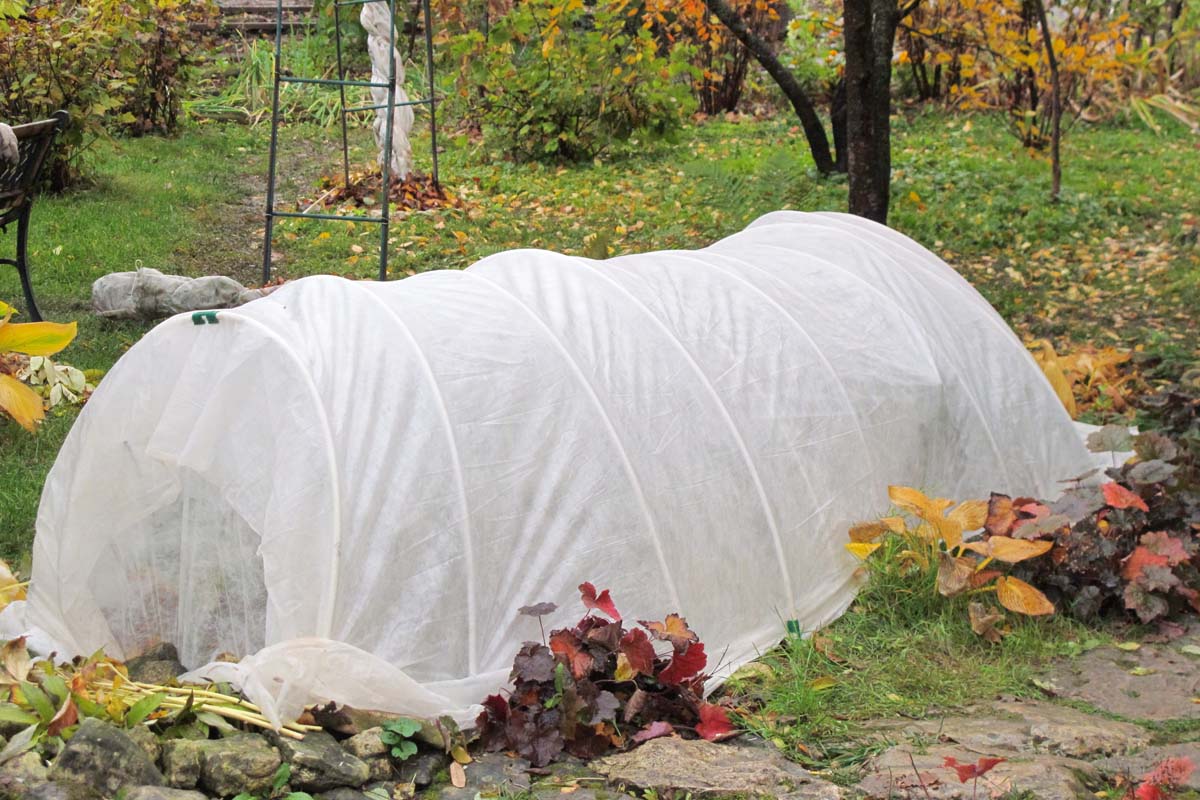
Although you can lay fabric directly over plants, consider building a permanent structure. This will allow you to use the material in a number of ways and allow for easy installation.
If stapling material to the ground, double up fabric to prevent ripping.
Store covers when dry and away from the ground, as rodents may find this makes a cozy bed.
Give Yourself the Option
It doesn’t take much to purchase a few yards of floating row cover. So what are you waiting for?

Sunpro 10Ft x 30Ft Row Cover via Amazon
When temperatures suddenly spike in April and threaten your lettuce crop, or dip and stress out your peppers, you’ll be thankful you made the extra investment.
Do you have experience using floating row covers? What are your thoughts? We would love to hear about what worked and what didn’t. Let us know in the comments!
If you enjoyed this guide, then some of our others may provide some more useful tips:

I have an unheated glass greenhouse, 7.5 x 10 feet. Last year it was warm and I planted in late Feb. Hard freeze killed everything and had to replant. Living in Northeast Illinois, when do you recommend planting in the greenhouse? Am itching to get going today!
Thanks, Paul
Hi Paul. Sorry for the delayed response, but hopefully this helps for next year! It’s hard to know with greenhouses as it depends on how much ‘winter’ sun they get, as well as the weather any given year. For cool season crops, especially kale, chard, and other hardier plants, I wouldn’t be surprised if they survive a good portion of the winter inside the greenhouse in Zone 5. For summer seedlings (tomatoes, peppers, eggplants), my best suggestion is to put a thermometer inside the greenhouse. If it’s consistently over 50*F inside, I would say you’re good to go. If it… Read more »
Hi there,
I am wondering to know if can give me some advice please? I am trying to start moving my cabbage transplants outside as early as the beginning-midle of April. However, my country’s (Mongolian) climate is not very friendly. In fact, during this period average nighttime temperature is around -8C and sometimes can reach even -10C but during the day it is around 8-13C. Thus, can you please give me some suggestions on keeping these cabbage transplants alive and healthy?
Many thanks
Hi Lee, Hardening off your seedlings during the day is probably your best best until the nighttime temperatures rise in your area. You’ll need to continue to keep them healthy indoors the best you can until the risk of frost has passed, transplanting them to larger containers if necessary. When nighttime temperatures are no longer going below freezing, begin taking your transplants outside during the day and exposing them to increasing amounts of partial sun each day for about a week until they are ready to be planted outside. Start at one hour, and increase the time spent outdoors incrementally… Read more »
I have my cucumber, yellow squash and zucchini under row covers to protect from squash borers. They’re now 2′ high- how do I get them out to trellis? cut holes in the row cover?
Hi Suzanne Turner, we’d recommend several different options. First remove the row cover. Then wrap each stem where it meets the ground with a 2×4 inch piece of aluminum foil with about 1/4 of that into the dirt; that should stop them from attacking the most vulnerable areas.
Suzanne Turner, we’d recommend several different options. First remove the row cover. Then wrap each stem where it meets the ground with a 2×4 inch piece of aluminum foil with about 1/4 of that into the dirt; that should stop them from attacking the most vulnerable areas.
Second option, apply Bacillus thuringiensis serotype kurstaki (Btk).
Third option would be to apply a suitable beneficial nematode although those are a bit slower acting. https://gardenerspath.com/how-to/disease-and-pests/beneficial-nematodes/
I just read a newspaper article about using these covers to protect trees/shrubs from the 17 year cicada hatch that is expected in my area. I have a new redbud tree (about 5′) that I don’t want to get damaged by the cicadas. any suggestions on how to use this material for that purpose. It’s currently netted around the trunk to protect from the deer, but the female cicadas will emerge from the ground and climb the tree to lay their eggs and I know my netting won’t stop that. Any suggestions?
Cicadas can certainly cause a lot of aggravation in the garden, not to mention the noise! You’re right that the females can cause damage to young trees including redbuds, dogwoods, fruit trees, and others when they lay their eggs, since the insects actually puncture the bark to create a safe space for them. You’re going to want to get started right away, so you can cover your tree before the cicadas start to emerge. Netting like what you would use for floating row covers is a good choice, since it is a light material that sunlight can penetrate, with tiny… Read more »
Hi, Last year we planted including eggplant, okra, and tomatoes in the open garden bed in the backyard. By the time they were ready to be harvested, we saw the attack from Japanese beetles and they started eating leaves from those plants. We tried using the pheromone “Bag a Bug” traps to combat Japanese beetles near to the bed, but saw a large increase of Japanese beetles around the bed. This year also, we planted the similar plants, but want them to be safe until the end. My question is that if we use these floating row covers, will this… Read more »
Thanks for your question, Prashant. One of the most important things to keep in mind with the traps with pheromone bait is that they should actually be positioned as far as possible from the plants that you want to keep them away from- since the traps attract the beetles, positioning them near your vegetable beds is actually putting out an alert to encourage more to come to the area, rather than encouraging the ones that are already there to look for food elsewhere. For more tips on combating Japanese beetles, check out our advice here. Floating row covers still let… Read more »
I found that pulling up the grubs before planting drastically reduces the problem. I save the grubs in a bowl for the robins.
Great article! Thank you so much!
You’re welcome, Alicia. Thanks for reading!
I’ve covered Swiss chard seedlings to prevent damage from leaf miners. Is it necessary to leave this on during the whole season or as the plant matures can the cover be removed?
Hey Linda, I’ve grown Swiss chard under row covers and have had equal parts great and terrible luck. Getting the chard started with row covers on top is beneficial. It allows the greens to really jump into the season with a strong start, and it prevents nibbling pests from doing damage while minimizing weeds from spreading. But I’ve had significant trouble when the chard starts to grow to maturity. If your row cover is tall enough to allow the plants to reach their full height, you should be in the clear to keep the chard under cover for (almost) your… Read more »
Hi thanks for the article! I was wondering if Reemay netting would be good for protecting lettuce from the heat?
Reemay cloth will definitely work to help protect lettuce from heat and bright light, and this can help to prevent early bolting in the summer. I use shade cloth on the raised beds where I grow my lettuce at home, and it works wonders! Depending on the size of the weave, you can even water through it if you wish to.
Can shade cloth be purchased at a fabric store. I remember buying a spun polyester at JoAnn Fabric four years ago but they don’t seem to have it now.
They may have some types of fabric that will work reasonably well at the craft store, but row covers and gardening products sold as shade cloth are designed to be weather resistant, to keep bugs out, and to let a specific amount of light shine through. For those reasons, a product intended for garden use will probably provide the best results.
Do you have a catalog? Want a small bubble. Need row covers, do you have a supplier?
Thanks for your message, Hilde. What size bubble are you looking for? We review recommended products but we do not sell them ourselves. Stay tuned for a future roundup of our favorite row covers and other products to extend the gardening season from our trusted affiliates.